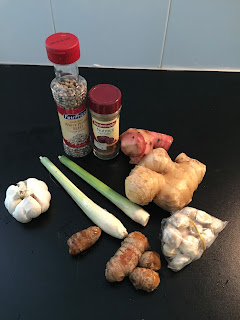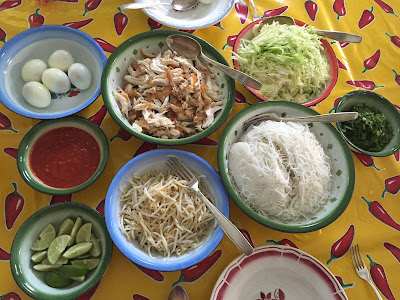 |
| Eveline with baby Karien in Oman (1977) |
My mother’s life as an expat wife would span thirteen years, in which she had three children and lived in as many countries. Many things we modern expats take for granted, like regular communication with loved ones in home countries, online shopping, or even modern hospitals simply didn’t exist in Oman in 1973. Curious to dig a little deeper into old memories and family stories I asked her some questions.
My father worked for Shell, how did the company prepare you before you left?
At the company headquarters there was one lady who told us about the ins and outs of expat life – mainly practical information like how much sea and aitfreigth we were allowed to take, and what we should pack. In Oman there was a small supermarkets in the camp (the compound where company employees lived), called the commy (or commissary) and there was one local outside. Otherwise there was the suq (market) in Matrah, Muscat's old town centre, but that was it when it came to shopping. Shoes, clothes and other items needed to be brought from Europe.
How was your arrival in the new country?
We arrived in the middle of the night, and it was very dark. There was no airport yet, just a small airstrip, from where we were brought to the PDO camp (Petroleum Development Oman is the local oil company). The camp was the only place with streetlights or any light in that dark night. The next day we first went to see the office and the company doctor, who was from the Netherlands. He told me that it was best for women to get pregnant as soon as possible, so you had something to do. That was quite strange to hear as an emancipated woman in the 1970s.
 |
| Eveline in Oman with Indian amah Lucy and two daughters (Karien on the left) (1976) |
Can you tell us about your first time there?
My husband was a PE (petroleum engineer) and had to work on an oil rig in the desert the first year and a half, which meant he was away for eleven night, and then home for only two. As an engineer he was on duty for 24 hours, opposed to the drillers who worked 8 hour shifts. Sometimes I would pick him up from the Skyvan, which was like a Volkswagen van with wings, and a bunch of neatly washed drillers came out plus one dusty block of tired cement: the PE.
After a long bath and a good meal he usually fell sound asleep. All of this meant getting pregnant wasn’t all that easy! Thankfully the company was considerate about these things: if after six months it still hadn’t happened, the husband could be temporarily moved to a desk job. Thankfully that wasn’t necessary for us, I still remember the exact day and time our first child was conceived.
And then you were pregnant, in a faraway country, with a man who was barely home. Giving birth wasn’t easy in Oman either. In the hospital goats roamed freely and whole Bedouin families camped out between the beds. So most expats went back to their home country at seven months, because after that you couldn’t fly anymore. You had to hope that the new father would make it in time for the delivery. He didn’t get any special leave so they would keep working as long as possible. Ideally you would fly back together, which usually meant traveling with a two-week-old baby. In a traveling cot that during the transfer in Bahrein was simply dumped in the boot of the taxi, they’d never seen anything like that there.
When our first child was born my husband barely made it in time. His flight was delayed so he missed his connection and, in those days, international phone calls couldn’t be made at airports yet. It was Christmas eve, and my first contractions had started. My brother went to the airport to collect my husband, and he did phone my parents’ house: all the passengers had alighted but he wasn’t there.
It turned out he had boarded the next available flight to Europe, which was to London, but we only found out after he landed there and could make a call. Thankfully he made it back in time, for Christmas dinner and the birth of our first daughter.
Was there any support for a woman that was alone so much?
The women in the camp supported each other. Especially with the other PE wives I was (and still am) close. Also many of the driller wives, as they were in the same situation. There wasn’t a lot of time for loneliness, there were always drinks and events, coffee mornings and diners where your presence was required. And there were a lot of sports and creative activities. Only the Arabic course I wanted to do was off limits. That was only for employees, not for us wives.
How did you stay in touch with family and friends in the Netherlands?
Staying in touch wasn’t as simple as it is now, where we use Whatsapp, Skype and email to stay in touch with our expat children. Making telephone calls was difficult, the connection between the camp and the post office in Muscat was very bad – it made more sense to drive to the post office in Muscat and made the call there.
Local calls with your husband on the rig were hilarious, you had to call via PDO radio, and people on all five rigs could listen in to how the, often newlywed, couples conversed. With ‘over’ after each sentence.
“I love you, over.”
“What do you say? Over.”
“I said I LOVE YOU. Over.”
For letters, people that went on home leave put a plastic bag on their front door, where you could put your mail, ideally with the correct postage. They would be posted for you somewhere in the Netherlands.
Where you in touch with people outside the camp, or Omani people?
We didn’t have much contact with the local people, only those which worked for PDO, as they spoke English. When we went on safari trips in the weekend to see the country and explore local villages, we would often meet people who had never seen any white people and we would try to converse with our hands and feet. They were always very hospitable and would offer drinks and food. It was quite disturbing to see that when after a few years the camp ‘opened up’ and no longer company IDs were required to enter, and curious Omani in large amounts came to have a look, all the expats were angry about this sightseeing. Nobody opened their house or offered food or drinks. Neither did I, I must admit.
How did the wives entertain themselves, what did your day look like?
Most people had an amah, or maid, from India, so household tasks didn’t take up much time. We organised playgroups for the toddlers and besides dropping children at the Shell primary school in the camp there was lots of time for entertainment. Because next to sports and arts and craft I wanted to do something a bit more meaningful six of us started a discussion group. Very strict. We’d sit at the dining table and weren’t allowed to talk about anything but the selected subject.
If I remember correctly, we started by reading ‘Herfsttij der Middeleeuwen’ a book on the Middle Ages by historian J. Huizinga. Later we discussed all sorts of subjects like ‘The Arab world in all its aspects’ and we read ‘The Prophet’ by Kahlil Gibran. Everybody would contribute based on her background. During home leave we would buy six each of interesting reading materials. This “Omanclubje” still exists and though unfortunately two of us passed away, we still meet up twice a year, and after exchanging family news we always discuss a book or article. We also started a documentation centre in the primary school library. That way we kept busy.
Lastly I should mention that for women that wanted to do more than talk about husband and children, maids and home leave, there were some, limited options. Very occasionally a job, as long as you didn’t take it from a local. Or it could be something you organised yourself, like scientific research or teaching swimming to employee children. When we moved back to Oman a decade later, there were some more options already.
In what way do you think your life would have been different had you stayed in the Netherlands?
Quite different. I probably would have eventually finished my law degree and have had some sort of job. But looking back I do feel privileged I was able to spend so much time with my children. And although I myself missed access to cultural things like museums, concerts and theatre living in such remote areas, they were lovely and carefree places for young children to grow up.
 |
| Karien with her Eveline and her two daughters in Singapore |
Looking back I can say our expat time enriched my life. You live in a very different culture. And even though we led fairly European lives in our Shell-camps, it changed your outlook on things. In the seventies we had the war in Lebanon, and even though that was still far from Oman, we did feel connected to it. And not only because a lot of our food was imported from Beirut, and there were suddenly only lettuce and onions in the shops. But because living in the Middle East gave us a more nuanced view on the matter. We noticed how in the Netherlands people had a very Israeli oriented outlook, where we were more understanding about the Arab side of things. The situation was also threatening, we had to pack a small suitcase just in case, and a large Shell tanker was readied to evacuate us if things would escalate.




















